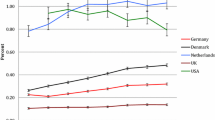Abstract
Background
The only drug approved for pervasive developmental disorders (PDD) in Japan is pimozide. Several psychotropic drugs are also prescribed for offlabel use in Japan, but details regarding their prescription and use are largely unknown. The purpose of this study was to clarify the use of drug treatment in Japanese children with PDD.
Methods
Data were extracted from claims data from the Japan Medical Data Center for children younger than 18 years of age who were newly diagnosed with PDD (International Classification of Diseases version 10 codes: F84) from 2005 to 2010 (total of 3276 patients as of 2010). The prescription rates were presented as the percentage of PDD patients who were prescribed each drug.
Results
Prior to 2010, the prescription rates for atypical antipsychotics, other antipsychotics, psychostimulants, all other central nervous system drugs, anticovnvulsants, non-barbiturates, and Parkinson’s disease/syndrome drugs significantly increased among the Anatomical Therapeutic Chemical classifications defined as the “nervous system” (trend P≤0.02). The prescription rate for risperidone consistently increased, reaching 6.9% in 2010 (trend P<0.0001), the highest rate of the surveyed drugs among the antipsychotics. The prescription rate for aripiprazole also increased (trend P<0.0001), reaching 1.9% in 2010. The prescription rate for pimozide showed no annual changes, with a low rate of 0.4% in 2010.
Conclusion
Compared with pimozide, the prescription rates for risperidone, aripiprazole and other psychotropic drugs have increased. Because safety data for these drugs in Japanese children are sparse, there is a need for future safety evaluations of these drugs in Japanese children.
Similar content being viewed by others
References
American Psychiatric Association. Diagnostic and Statistical Manual of Mental Disorders, 4th ed, Text Revision (DSMIVTR). Arlington, VA: American Psychiatric Publishing, Inc, 2000.
Fombonne E, Zakarian R, Bennett A, Meng L, McLean-Heywood D. Pervasive developmental disorders in Montreal, Quebec, Canada: prevalence and links with immunizations. Pediatrics 2006;118:e139–e150.
Janca A, Ustun TB, Early TS, Sartorius N. The ICD-10 symptom checklist: a companion to the ICD-10 classification of mental and behavioural disorders. Soc Psychiatry Psychiatr Epidemiol 1993;28:239–242.
Johnson CP, Myers SM. Identification and evaluation of children with autism spectrum disorders. Pediatrics 2007;120:1183–1215.
Kawamura Y, Takahashi O, Ishii T. Reevaluating the incidence of pervasive developmental disorders: impact of elevated rates of detection through implementation of an integrated system of screening in Toyota, Japan. Psychiatry Clin Neurosci 2008;62:152–159.
McPartland J, Volkmar FR. Autism and related disorders. Handbook of clinical neurology 2012;106:407–418.
Posey DJ, Stigler KA, Erickson CA, McDougle CJ. Antipsychotics in the treatment of autism. J Clin Invest 2008;118:6–14.
Kirino E. Efficacy and tolerability of pharmacotherapy options for the treatment of irritability in autistic children. Clin Med Insights Pediatr 2014;8:17–30.
Aman MG, Lam KS, van Bourgondien ME. Medication patterns in patients with autism: temporal, regional, and demographic influences. J Child Adolesc Psychopharmacol 2005;15:116–126.
Green VA, Pituch KA, Itchon J, Choi A, O’Reilly M, Sigafoos J. Internet survey of treatments used by parents of children with autism. Res Dev Disabil 2006;27:70–84.
Oswald DP, Sonenklar NA. Medication use among children with autism spectrum disorders. J Child Adolesc Psychopharmacol 2007;17:348–355.
Rosenberg RE, Mandell DS, Farmer JE, Law JK, Marvin AR, Law PA. Psychotropic medication use among children with autism spectrum disorders enrolled in a national registry, 2007-2008. J Autism Dev Disord 2010;40:342–351.
Witwer A, Lecavalier L. Treatment incidence and patterns in children and adolescents with autism spectrum disorders. J Child Adolesc Psychopharmacol 2005;15:671–681.
Kimura S, Sato T, Ikeda S, Noda M, Nakayama T. Development of a database of health insurance claims: standardization of disease classifications and anonymous record linkage. J Epidemiol 2010;20:413–419.
Huffman LC, Sutcliffe TL, Tanner IS, Feldman HM. Management of symptoms in children with autism spectrum disorders: a comprehensive review of pharmacologic and complementary-alternative medicine treatments. J Dev Behav Pediatr 2011;32:56–68.
Ching H, Pringsheim T. Aripiprazole for autism spectrum disorders (ASD). Cochrane Database Syst Rev 2012;5:CD009043.
Yoshida Y, Uchiyama T. The clinical necessity for assessing Attention Deficit/Hyperactivity Disorder (AD/HD) symptoms in children with high-functioning Pervasive Developmental Disorder (PDD). Eur Child Adolesc Psychiatry 2004;13:307–314.
Gillberg C, Gillberg IC, Rasmussen P, Kadesjo B, Soderstrom H, Rastam M, et al. Co-existing disorders in ADHD —implications for diagnosis and intervention. Eur Child Adolesc Psychiatry 2004;13 Suppl 1:I80–I92.
Gadow KD, De Vincent CJ, Pomeroy J. ADHD symptom subtypes in children with pervasive developmental disorder. J Autism Dev Disord 2006;36:271–283.
Leyfer OT, Folstein SE, Bacalman S, Davis NO, Dinh E, Morgan J, et al. Comorbid psychiatric disorders in children with autism: interview development and rates of disorders. J Autism Dev Disord 2006;36:849–861.
Correia CT, Almeida JP, Santos PE, Sequeira AF, Marques CE, Miguel TS, et al. Pharmacogenetics of risperidone therapy in autism: association analysis of eight candidate genes with drug efficacy and adverse drug reactions. Pharmacogenomics J 2010;10:418–430.
Lit L, Sharp FR, Bertoglio K, Stamova B, Ander BP, Sossong AD, et al. Gene expression in blood is associated with risperidone response in children with autism spectrum disorders. Pharmacogenomics J 2012;12:368–371.
Dulcan M. Practice parameters for the assessment and treatment of children, adolescents, and adults with attention-deficit/hyperactivity disorder. American Academy of Child and Adolescent Psychiatry. J Am Acad Child Adolesc Psychiatry 1997;36:85S–121S.
Baxter AJ, Vos T, Scott KM, Norman RE, Flaxman AD, Blore J, et al. The regional distribution of anxiety disorders: implications for the Global Burden of Disease Study, 2010. Int J Methods Psychiatr Res 2014;23:422–438.
Author information
Authors and Affiliations
Corresponding author
Rights and permissions
About this article
Cite this article
Satoh, M., Obara, T., Nishigori, H. et al. Prescription trends in children with pervasive developmental disorders: a claims data-based study in Japan. World J Pediatr 12, 443–449 (2016). https://doi.org/10.1007/s12519-016-0036-8
Received:
Accepted:
Published:
Issue Date:
DOI: https://doi.org/10.1007/s12519-016-0036-8




